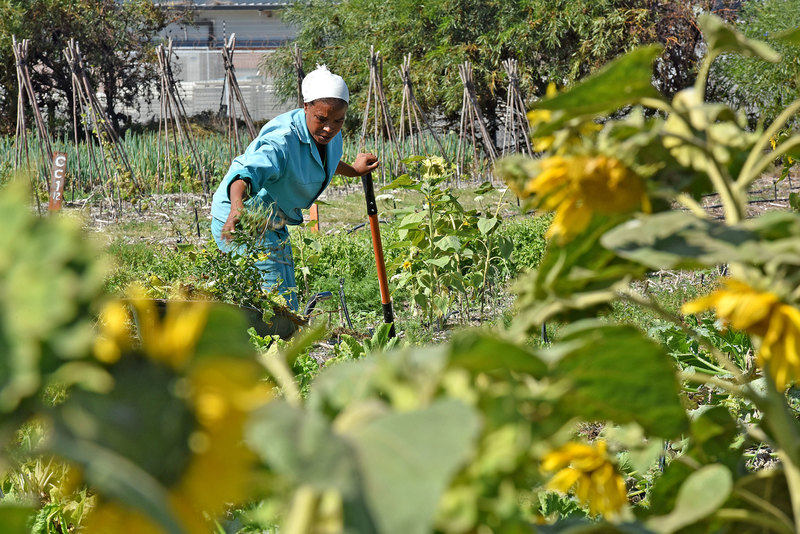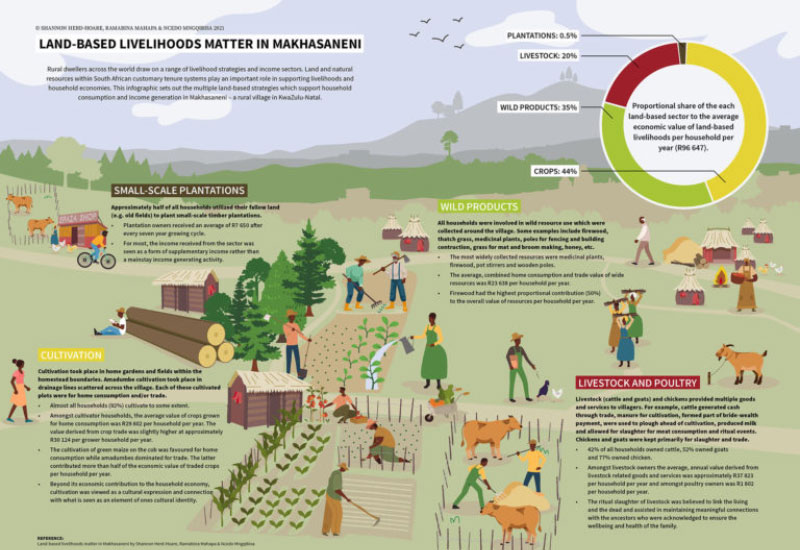Understanding fair compensation for mining-affected communities moved from their land
24 June 2021 | Story Shannon Herd-Hoare and Ramabina Mahapa. Read time 6 min.
The discussion about what constitutes fair compensation for rural mining-affected communities who are moved from their land cannot simply be left to a calculation of the market value of material elements such as homesteads and land improvements. This, according to Ramabina Mahapa, a researcher with the Land and Accountability Research Centre in the Department of Public Law at the University of Cape Town, and environmental researcher Shannon Herd-Hoare.
Almost a century ago, the residents of Makhasaneni in rural KwaZulu-Natal were forcibly moved from their homes in eMagogogweni to make way for a timber plantation. The colonial government of the 1930s relocated them to a spot between the towns of Eshowe and Melmoth where they worked hard to re-establish themselves. The difficulties of that move remain in their collective memory.
Now, they face another possible relocation, this time because an iron ore mining development is earmarked for their land.
Their urgent and pressing question is: if mining comes to Makhasaneni, will they be compensated fairly, and what does that look like?
In October 2018, in the case in which the principle of compensation for mining-affected communities in South Africa was unambiguously affirmed (Maledu and Others v Itereleng Bakgatla Mineral Resources (Pty) Limited and Another), Constitutional Court Justice AJ Petse opened his unanimous judgment by quoting a passage from Frantz Fanon’s The Wretched of the Earth. He wrote, “for a colonised people the most essential value, because the most concrete, is first and foremost the land: the land which will bring them bread and, above all, dignity”.
The judgment held that owners and lawful occupiers of land affected by mining are entitled to compensation prior to the commencement of mining development in terms of Section 54 of the Mineral and Petroleum Resources Development Act. Yet, it remains unclear what fair compensation looks like for loss or damage as laid out in the act.
The Land and Accountability Research Centre, based at the University of Cape Town’s Law Faculty, recently conducted research to try to identify the elements that need to be taken into consideration in determining just and equitable compensation for communities who are faced with a potential loss of community land rights and land-based livelihoods.
Commonly, compensation analyses are focused solely on the market value of land or immovables such as homesteads, but the centre’s research proposed that any assessment should be broadened to also include valuation of the economic as well as cultural aspects of rural residents’ dependence on their land to support their livelihoods.
The exclusion of these aspects in conventional compensation assessments helps to explain why so few communities have been left better off after being displaced by mining, and moreover, why so many communities choose to resist mining development on their land.
Covering roughly 16km2, Makhasaneni consists of about 300 households dispersed across the landscape and linked by footpaths. Under the apartheid regime the area formed part of the KwaZulu homeland, but under the democratic dispensation it falls within the Mthonjaneni local municipality.
The first signs that a possible mining development would affect the village came in 2011 when prospecting for iron ore began in the area. These activities destroyed several family graves, streams and ploughing fields. Massive resistance by the residents ensued and in 2016 the mining company withdrew its application for a mining licence. But that was not the end of the story. Renewed attempts to conduct mining activities in Makhasaneni started in late 2019 and are ongoing.
Land and Accountability Research Centre researchers went to the area in late 2019 and early 2020, surveying 100 Makhasaneni households and conducting in-depth interviews with 20 key residents. The surveys and interviews provided empirical evidence that showed unquestionably that arable agriculture, livestock husbandry, wild resources and out-grower timber production (cultivation of trees to supply to bigger timber producers) make measurable contributions to rural livelihoods in this community. The determination of compensation for displacing this community cannot be made without considering these aspects.

The research found that all households in the area were involved in activities that relied on the land (land-based livelihoods), although the degree of involvement varied between households. Cultivated home gardens and fields located next to the homestead yielded vegetables collected daily for household consumption and for selling. In many instances thriving fruit trees, such as mango, avocado and guava surrounded homesteads and were collected by the bucketload when in season.
Direct access to cultivated crops provided support during times of need, as one 62-year-old resident explained: “When I was young I did not latch on to my mother’s breast, so she used to crush maize to feed me. So even when my mother was helpless, the land provided.”
For some, the practice of cultivation was significant for reasons more than mere crop production and represented a form of cultural expression and a connection with an element of their cultural identity. One female informant said: “I am a Zulu woman; cultivation is part of who I am.”
Pockets of indigenous forest in the area yield valuable wild resources that include firewood, medicinal plants, poles for fencing and kraal construction, and honey. Incised drainage lines are accessed for the perfect wet conditions they provide for the growth of taro root, locally known as Amadumbe, and grass for mat making. Grassy slopes boast a range of wild fruit trees, such as Indoni berry and Amahlala, and grasses for making brooms.
The information gathered by the researchers revealed a community reliant on a range of resources the land provides, and whose interaction with the landscape has been firmly embedded in their local identity.
When quantified in purely economic terms, the average annual cash (through sale) and non-cash (through home consumption) value across all land-based livelihood sectors in this community was R96,647. In other words, the average economic value received from land-based goods and services per household per year was R96,647.
Crops were the highest contributors to this amount (44%), followed by wild products (35%), livestock (20%) and plantations (0.5%). In addition to this land-based livelihood income, the household economic portfolio of Makhasaneni residents was supplemented by some income from off-farm activities such as wage labour on neighbouring Mondi plantations or commercial farms, spaza shops, trade of sorghum beer, hairdressing and building which accumulated an average of R32,716 per household per annum, and income derived from social grants, including child, old age and disability grants, which represented about R27,551 per household per year.
Beyond the rand value of land-based livelihoods, which are key for survival or self-sufficiency in the economic sense, land reliance was also found to be importantly related to the community’s cultural identity. The continual investment into and development of what were described as traditional activities, such as the purchase or sale of livestock, the phased management of land in category cycles such as from rangeland to out-grower forestry, and the generational investment of time and labour into cultivated plots, was expressed as essential to their agrarian identity — and an important element of being a rural inhabitant.
The discussion about what constitutes fair compensation for rural mining-affected communities who are moved from their land cannot be simply left to a calculation of market value of material elements such as homesteads and land improvements. In the example of the residents of Makhasaneni, the evaluation and compensation for the loss of the land on which they directly rely should be understood as roughly R96,000 per household per annum. This is a quantum that is potentially the difference between economic survival and dire poverty.
The many ways in which rural residents use and are connected to their land need to be weighed in their full complexity to arrive at an understanding of what it means to place an individual in the same position that he/she would have been had the disruption and dislocation from their land not occurred.










